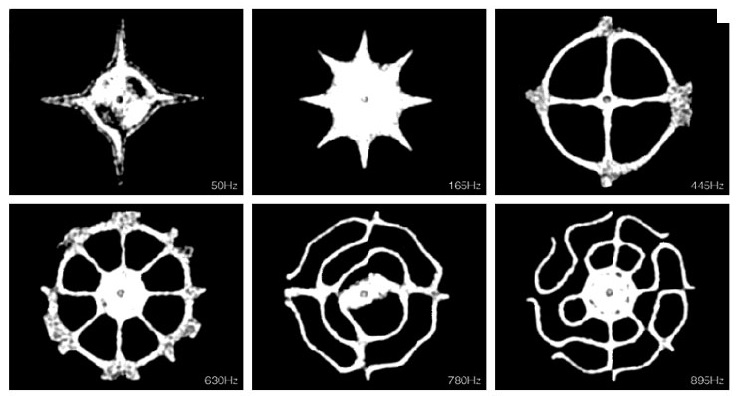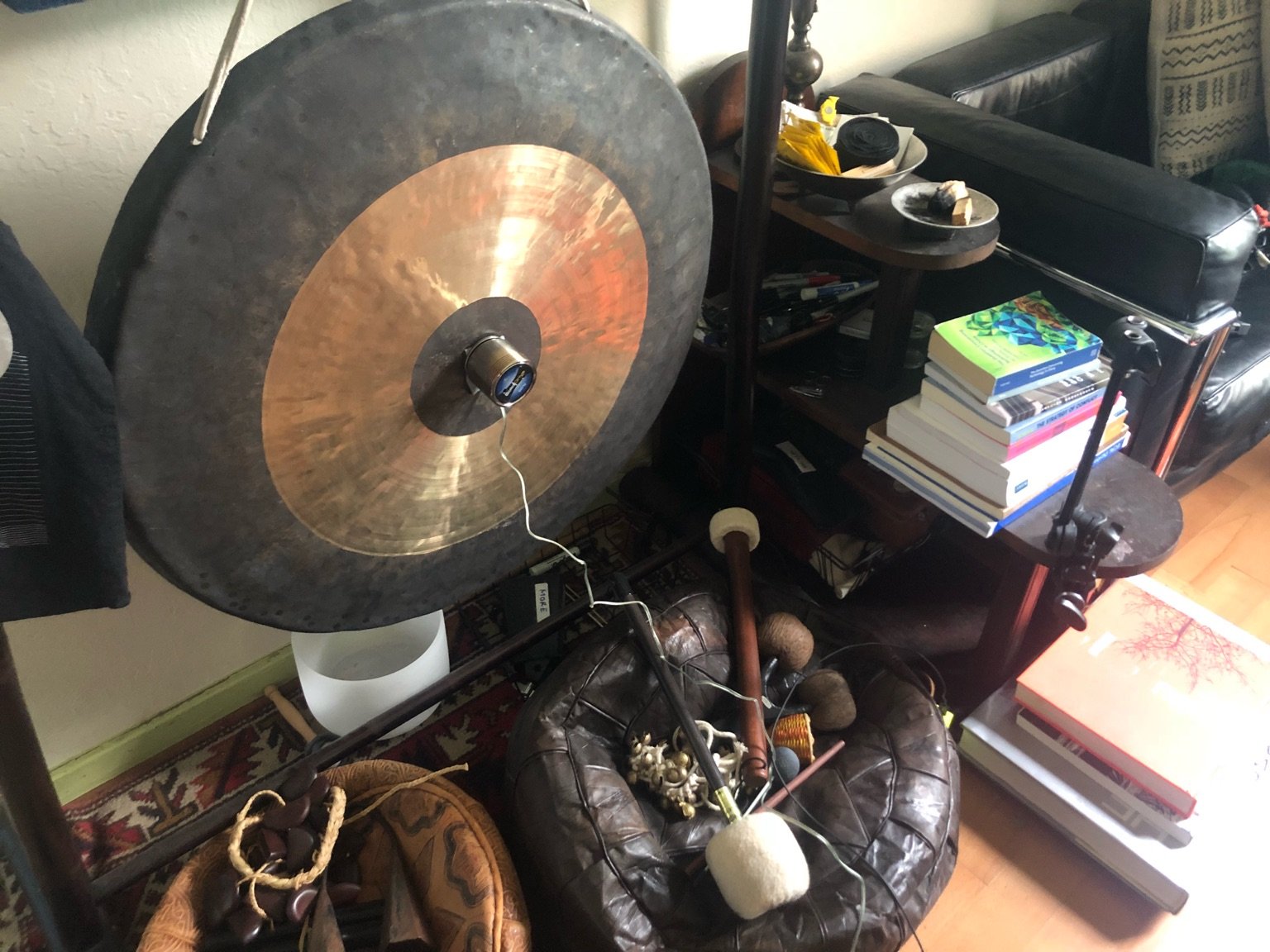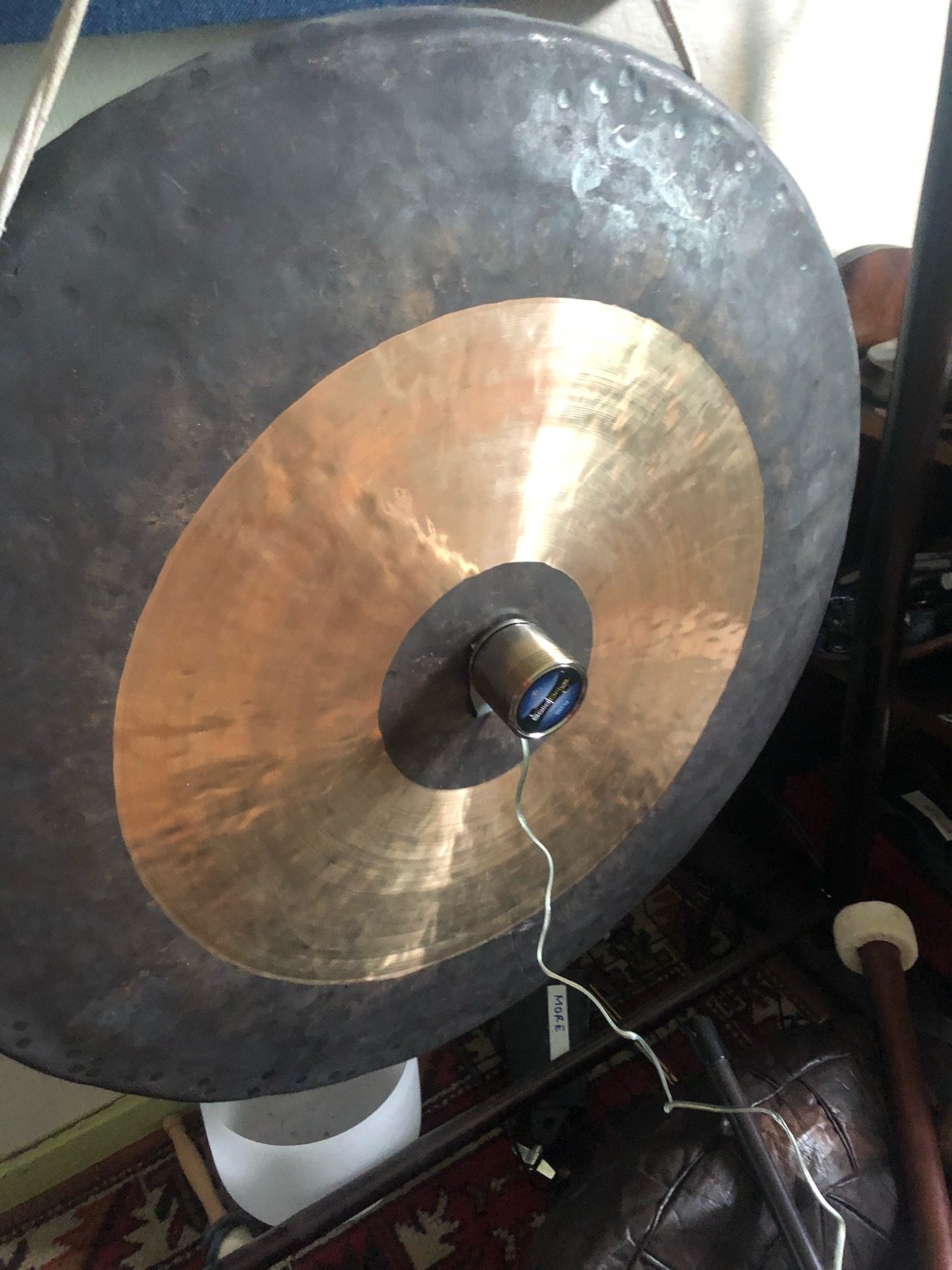Gong Studies

Cymatic patterns of a chau gong excited at various frequencies
with surface transduction (pictured right ︎)
with surface transduction (pictured right ︎)

I’d bathed in their unbridled timbres at meditations and noise shows always lusting after their inharmonic blossoming but a few years ago I finally took the plunge into the primorial sound chasm and procured a 36” Chau gong. After using them in studio drone sessions and various rituals, I’m finally getting around to doing a formal set of études.
It is considered that tin was the first metal to flow from stones around 10,000 B.C. As the ovens were capable of getting hotter metallurgists began to separate copper from rocks around 6,500 B.C. The Bronze Age began around thousand years later when the ovens were big enough to allow for the melding of the two. Ancient gong makers discovered that meteorites, when thrown into the casting melts, added to the quality of bronze giving it an improved resonant tone, more powerful and spacious, sustaining its vibration for much longer. The early gong alchemists didn’t know that the special ingredient provided by meteorites was nickel, since during that era of metallurgy it was never found naturally on the surface of the Earth. So it turns out that those dreadlocked ‘sound healers’ that claim that gongs are ‘celestial’ are actually indirectly vindicated ― early gongs partially came from outer space.
Chaotic State Transitions & the Non-Linear Physics of Gongs
Most tonal musical instruments are often thought of as linear harmonic systems, and a first-order description of their operation can often be given on this basis with a few inharmonic exceptions such as drums and bells. In impulsively excited instruments, such as gongs and cymbals, the nonlinearity is ‘incidental’ including transitions to chaotic behavior.
The allure of a gong is in its signature inhamonic blossoming which is derived from its indeterminate resonance. At a critical amplitude, and over a very small frequency range near the admittance peak, the periodic motion of the gong will develop high amplitude subharmonic components. When I sit in front of the gong I can literally feel thermal energy emissions cascading off the bronze surface. This behavior is critically dependent on the frequency, amplitude, and immediate history of the excitation, but subharmonics of orders 2, 3, and 4 are evoked. Associated with these subharmonics are all multiples of their frequencies. Sometimes the number of peaks on the spectrum are so large that unambiguous assignment of fractional frequencies is not possible, and since the unresolved background intensity is also large, the motion may reasonably be described as chaotic. Subjectively, the sound produced by the gong when vibrating in one of these multiple-subharmonic modes is very similar to the fully developed after ring of the gong when excited by a vigorous blow.

The normal modes of gongs are inharmonic, but no attempt is made to tune them to a harmonic or quasi-harmonic series. Instead, the shape and material of the gong determines its spectrum and, when gongs are used in combination, and with the addition of tuned-bar instruments their modal frequencies in turn determine the musical scale. The gongs of the gamelan do not exhibit any marked nonlinearity, because they have thick and highly curved walls, and are played at a moderate dynamic level. However, the wind & Chau gongs of the Chinese opera orchestra that you’ll hear in these études are made of bronze no more than 6mm in thickness and, since they represent climaxes in the action, are struck very vigorously with a padded hammer, excited with rubber, and modulated with amplified transduction (SolidDrive SDG1).
The nearly flat central section of the gong is the active vibration region, while the stiffer conical surround both supports this disk and acts as a baffle to increase the sound radiation. The difference in geometry and material between Javanese and Chinese gongs makes an immense difference to the sound in loud playing, though if the gongs are stuck softly they produce a simple and nearly sinusoidal tone at the fundamental frequency of the primary mode.
This means that the stiffness and tension of restoring forces are very small, so that the quadratic tension generated by mode displacements has a profound physical effect. Another source of mode coupling and nonlinearity arises from the hammered bumps in the surface since abrupt changes in slope are known to generate mode coupling and nonlinear frequency multiplication.
Surface Transduction & Bronze Meditations:
The vibration patterns of the gong observed are exciting the surface with a sinusoidal signal (via SDG1 transducer) and room feedback.
Ketamine Mantis Mother:
This take is a from expanded studio percussion performance that included excitation with caxixi, steel springs, plastic vacuum tubing, rattles, various steel rods, aluminum plates, chop sticks, frame drum, rubber mallet, 1/2” chain mesh
Mallet Variations:
The vibration patterns of the gong were observed by driving the plate at edge with various mallets (rubber, padded hammer).
Padded Hammer
Rubber Mallet
Resources:
Microphones: Neumann KM150 Stereo Hypercardioid Condensors
Gong: 36” Wuhan Chau Tam Tam
Exciters: SDG1 SolidDrive transducer, rubber mallet, steel springs, plastic vacuum tubes, caxixi, steel rods, aluminum plates, bow, 1/2” chain mesh